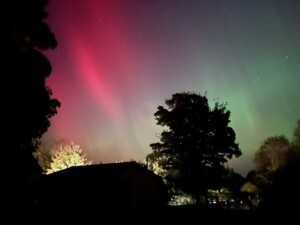Residents in Dublin are being encouraged to share their photos of the Northern Lights to help build Ireland’s largest ever archive of aurora images.
A researcher in the Dublin Institute for Advanced Studies (DIAS) is calling on the public to submit photos taken across the country, particularly in Dublin’s dark-sky locations.
In May and October 2024, the Northern Lights were visible across the island of Ireland, caused by some of the most intense geomagnetic storms of the 21st century.

Example of the Northern Lights in October 2024, Photo by Sadhbh Leahy
These storms were highly documented by people across the island of Ireland through photos on their phones and cameras, and DIAS researchers are now asking for people to share these images as part a of a citizen science research project.
To find out more and submit your photos visit https://www.dias.ie/cosmicphysics/astrophysics/aurora-eire/
Dr Alexandra Ruth Fogg, Postdoctoral Fellow with DIAS School of Cosmic Physics, is the lead researcher who is asking for the public to contribute their images to her research so as to create a comprehensive dataset:
“We want to create the first archive of auroral photos from the island of Ireland during these exciting events.
“Using these photos, we will be able to map the location, brightness, colours and shapes of the aurora across Ireland during these two storms.
“All of these characteristics of the aurora can tell us different things about what’s happening in space. This will give us new and unprecedented information about space weather local to Ireland.
“This research will contribute to our understanding of space weather, which is a natural hazard and will help to bolster local space weather preparedness for the island of Ireland, which is a priority for the Irish government.
“Calling for as many people as possible to submit images as they can, Dr. Fogg said: “The more images we collect from the public, the more information we will be able to find out. If we are able to gather a large archive of photos from people across the island of Ireland, our dataset can become one of the best scientific resources for analysis of the structure and form of the aurora during these two storms”.